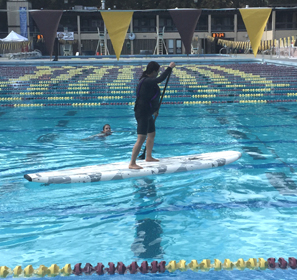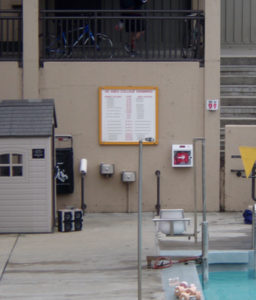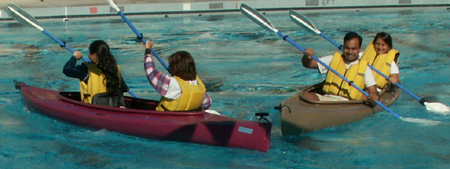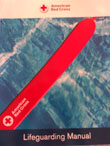 KNES 001A (formerly P.E. 26A) is the Novice swimming class at De Anza.
KNES 001A (formerly P.E. 26A) is the Novice swimming class at De Anza.
For info about the class click on these links:
If you are not sure whether this is the right class for you, read a description of typical students and goals of the class at: Novice swimming
Novice Swim FAQs has the cost, etc.
If you think you can’t learn to swim, read Letters from novice students

How to find the pools, sunscreen, P/NP grading, waitlists and more
are covered at
See also: How to get a P.E. locker at De Anza College
_________________________________
Summer 2019 you can register for a novice swim class five Saturdays (instead of the usual 11),
July 6, July 13, July 20, July 27 and August 3, 10 am – 2:30 p.m.
Register for (12800) KNES 1A 01L
We will be in the pool the first class (Saturday, July 6), so bring your swimsuit, towel, sunscreen, (optional) swim cap.
for summer 2019 the syllabus is at: KNES 1A course syllabus summer 2019
If you read about it too late to add, please at least be enrolled at De Anza before the first class so you can add if we find we have the space. The first day of class summer quarter is also the last day to add summer quarter classes and there will not be enough time for people to apply to the college and be able to use an add code.
Enrollment and registration steps for De Anza College are at: http://www.deanza.edu/apply-and-register/
Info about parking permits, including electric vehicle charging stations, is at: http://www.deanza.fhda.edu/parking/
Find the pools (the light blue square and rectangle in about the center) of this campus map :
http://www.deanza.edu/maps-and-tours/documents/campusmap_20180413.pdf
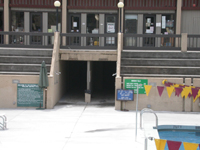
To get from the pool deck to the locker rooms, women enter the tunnel on the RIGHT from the pool deck and go directly up to their locker room. Men enter through the LEFT entrance and go down a hall to their locker room.
Men should note that there is a storage room in the left tunnel that is accessed by both female and male personnel, and they should change clothes in the locker room, not the tunnel.
At the exterior pool end of the tunnel there are showers on the wall, especially good when the locker-rooms are closed.
____________________________
No, it is not too cold to take a swim class in an outdoor pool. The pool is heated enough for seniors exercise programs. A swim cap makes you warmer and faster. You can also stay warmer (and have more modesty) with ‘rash guard’ type tight-fitting shirt, cyclists shorts, but many people just go ahead and swim. (I often wear one or two men’s ‘jammer’ long-legged swimsuits over my regular suit when I swim at 6:30 a.m. in the winter.)
below, lifeguard Samir and swimmers model warm swimwear including various coverages of rash guards and jammers:
![]()
Many people wear a long sleeved rashguard top and jammers (men’s longer legged swim suit) for extra sun protection, modesty or warmth.
Ladies wear them for more coverage over their regular swim suit.
Some buy a spring (short sleeve, short leg) wetsuit for warmth.
If you want full coverage of your body, including arms, legs, neck and head, I suggest searching for Muslim swimsuits or full body modesty or Islamic modesty swimsuit. You can find designs for triathletes that will not interfere with swimming movements. Unfortunately, some modest swim “costumes” do interfere. I suggest that you look for a training, competition or triathlon swim suit in one piece, without a skirt or loose top, without loose legs, and without a hat brim at the top of the forehead on the head covering. The head covering / hood should not interfere with your vision to the side as you move. Some people wear a rash guard type athlete’s suit with long legs, long arms and no hood, but wear a swim cap rather than a full hood. Some are made of materials that can provide sun protection.
____________________________
You need to know where these are:
After some of our class sessions I will be responsible for locking up the pool complex entrance gates. If you are in a restroom or the locker room when I lock up you need to know which exit (door/gate) you can use to get out of the complex. The doors/gates between PE buildings PE1 and PE2 are locked from the outside but have bars you can push on from the inside to get out. See buildings PE1 and PE2 at this map:
http://www.deanza.edu/maps-and-tours/documents/campusmap_20180413.pdf
or this map:
https://www.deanza.edu/maps-and-tours/pe_quad.html
And, the classroom we will be using at the start of many classes (to watch Red Cross / USA Swimming how-to-do it videos) will be PE12U. To get to it from the pool deck, you would go through the doors/gates between PE buildings PE1 and PE2, turn left and look for a door in the building on your left with stairs up to PE12U. see map
(Ooooops, the tiny yellow letters in the photo above that you can barely read are where the door is.)
____________________________
Pictures from summer quarter 2010: (jumping off the diving boards is optional in this class, but most students try it by the end of the quarter. Practice kayaking is an optional Outdoor Club event, not always a part of the class, but a lot of novice students join in the practice.)
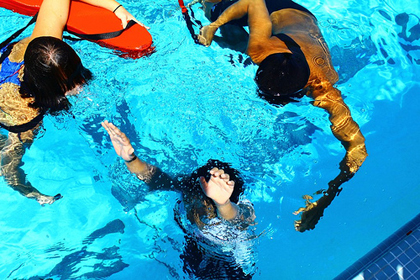
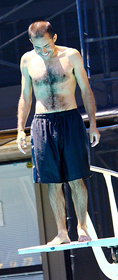
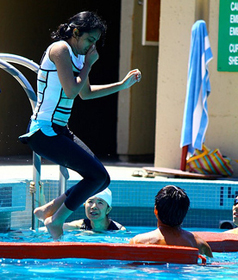
Pictures from fall quarter 2010:
two photos below from Sumana Praharaju
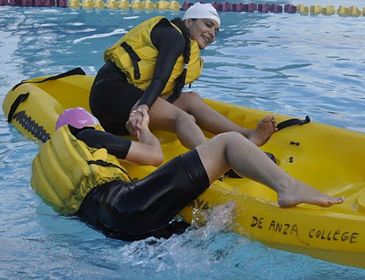
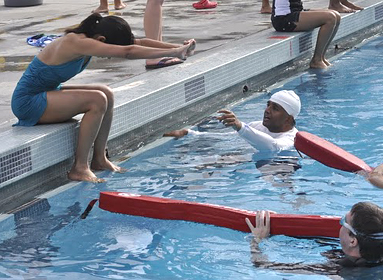
photos below from Guru Parab
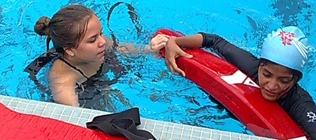
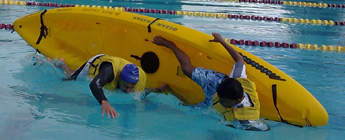
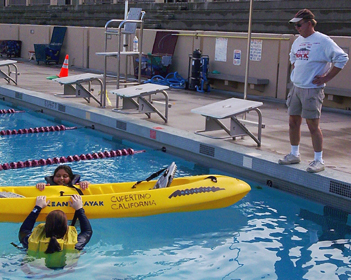
Practice on a stand-up paddleboard (SUP) is optional, and not always a part of the last day of class:
Homework … in a swim class??
All swim classes at De Anza share the same curriculum, (the course content, designed by De Anza College). Each instructor must teach the same of skills and knowledge about swimming, but each instructor can go about reaching these goals in various ways.
You do not need to buy a textbook for any class I teach. (The text costs $128.60 at the bookstore as of winter 2017.) There are some copies of the text for this class on reserve in the Learning Center. Students can share a book. If you have already purchased any version of the series, or choose to buy an older version, any version will work for this class. We will talk about this in detail the first day of class, so please put off buying the text until after the first class session.
De Anza requires that swim students are taught strokes, treading water and underwater swimming, (and in higher level classes, turns and diving), and the curriculum says that novice swim students will:
Examine the global and historical development of swimming from survival to competition.
Experiment with the laws of physics as they apply to basic swimming skills.
Apply basic exercise physiology and nutrition to swimming.
Analyze causes of drowning and apply safe water practices.
Examine body position as it relates to individual stroke components.
Combine stroke components into whole swim strokes.
Demonstrate the ability to perform one major swim stroke for a distance of 25 yards.
De Anza also specifies that there will be assignments, such as:
Reading
1. Assigned readings from the text book ‘Fit and Well” by Thomas Fahey et al.
2. Review instructor generated handouts on basic swimming skills and water safety. (For this class the “handouts” are online and we will watch Red Cross/ USA Swimming how-to-swim videos.)
Writing –
1.Essay on one of the five components of fitness based on the textbook “Fit and Well” by Fahey et al.
(The five components to choose from are: cardiorespiratory endurance, muscular strength, muscular endurance, flexibility, and body composition, each a chapter in the text.)
2.One short essay on the history of swimming or swimming in the student’s home country
3.Graded comprehensive final exam based on textbook readings and handouts
These areas would require hours of lecture to cover them as required. In an effort to be able to spend more time in the water I have developed some short online reading assignments to cover most of them. Those that cover the De Anza requirements are required for a passing grade; do more and you can earn a higher grade.
Relax, these are short assignments.
Often the easiest way to do an assignment is to run your mouse across some of the text, copy it (click Ctrl C or Apple C on many computers) and paste it (click Ctrl V or Apple V) to a blank document on your computer. You can handwrite any assignment but it must be easily readable, so block printing is preferred and must be in letters at least as big as the type on this page.
If you use a printer, or write with a pen, use black or dark blue ink.
The De Anza library has a lab where you can access computers:
http://www.deanza.edu/library/librarywestcomputer.html and a few laptops for loan to students: http://www.deanza.fhda.edu/library/laptop.html
Please note: you are responsible for keeping a copy of each assignment in case the one you turn in is lost.
No homework assignments will be turned in online.
I do not accept early or emailed assignments.
All homework must be in my possession, (not in a mailbox, etc.) by 2:30 p.m. August 3 and I do not accept emailed homework.
_________________________________________________
– – – – – – – – – – – – – – – – – – –
The De Anza Library has free access for current students to the New York Times. Go to the library home page: http://www.deanza.edu/library/ and click on, The New York Times. At the next screen, log in with your Portal IDs. On the next screen, create an account.
– – – – – – – – – – – – – – – – – – –
Free flu shots for students are offered each Fall quarter and often available later quarters. https://www.deanza.edu/healthservices/
_________________________________________________
HOMEWORK
Because we meet for only five sessions summer quarter instead of the 11 classes other quarters, each summer quarter class is the equivalent of two fall, winter or spring quarter classes. There is more homework each Saturday.
Each first Saturday of the month (including July 6 and August 3)there is a flea market at De Anza, (unless it is totally rained out), taking up a lot of parking space. There will be parking attendants asking for ten dollars to park, but if you have purchased a quarter-long permit and tell them you are there for a swim class, they should let you in without paying extra. DO NOT try to park in the lot on the east (Stelling road) side of the campus, there is almost always much more room, and less hassle if you park in lot E, on the other side of the PE quad. Find Lot E at: http://www.deanza.edu/maps-and-tours/documents/campusmap_20180413.pdf OR try the Flint Center parking garage, at the Stevens Creek and highway 85 corner of the campus, as even the top floor has space most Flea Market days. You will need to plan time for the walk from there, but that could be faster than driving around and around looking for a parking space.
Completed in class the first session, Saturday, July 6 :
(People who were enrolled or waitlisted before summer quarter started got an email from me with the first homework to do and a link to the syllabus to read. People who do not bring the swim class safety rules homework with them to class will do it during class time before they are allowed to get in the pool.)
Read the course syllabus , which has the grading standards, class rules, how to do makeups and more. You are responsible for the material in this document. (This is also known as the ‘greensheet’ in many De Anza classes.)
Read the swim class safety rules webpage and briefly write up three new safety rules you find. If you already knew all of them, write up the three most important to you. To avoid confusion in recording your homework put your name at the top of the page, and the title safety rules.
Note that I said briefly write up; these assignments do not require paragraphs and paragraphs of verbose prose.
After class, start your personal practice journal (described in the course syllabus).
– – – – – – – – – – – – – –
Reading on preventing swimmer’s ear and cramps, with no writing assignment required:
http://www.cdc.gov/healthywater/swimming/rwi/illnesses/swimmers-ear-prevention-guidelines.html
STOP THAT CRAMP! 4 causes — and solutions — for muscle cramps during exercise
http://www.usms.org/articles/articledisplay.php?aid=1322
You should remove your piercings… optional reading: body piercings and lifeguards: http://www.aquaticsintl.com/lifeguards/saving-your-skin.aspx
Along with the stretches we will try in class, this could also help:
U.S. Masters Swimming has tips for stretching for swimmers.
http://www.berkeleywellness.com/fitness/exercise/article/3-great-back-stretches
http://www.berkeleywellness.com/fitness/active-lifestyle/lists/7-smart-stretching-tips-/slideid_206
U.C. Berkeley Wellness, in Exercise Away Your (lower) Back Pain http://www.berkeleywellness.com/fitness/injury-prevention/exercise/article/exercise-away-your-back-pain says: “Walking is also good for the back, as is swimming (avoid the butterfly and breast stroke, which can put excessive strain on the lower back).”
– – – – – – – – – – – – – – – – – – – – – – – – – – – – – –
Each swim class at De Anza includes curriculum about hydrodynamics, some of which we usually discuss the first day of class.
“A. Experiment with the laws of physics as they apply to basic (or beginning, intermediate or advanced) swim skills.
1. Archimedes’ principle – the human body in relation to water density
2. Buoyancy, specific gravity, and displacement
a. Fat versus muscle in determining flotation capability
b. Male vs. female
c. Center of mass vs. center of buoyancy and equilibrium
d. Supine floating versus prone floating
3. Drag and resistance – form drag, wave drag, and frictional drag
4. Efficient versus inefficient body movement while in water – streamlining the body
5. Bernoulli’s theorem and laminar flow – lift
6. Conservation of momentum, laws of inertia, acceleration, action and reaction, and levers”
We review the above mostly by applying the theories to swim skills, thinking about why, for example, when people swim underwater with straight arm pulls it is not as effective as with a bent arm pull. Each class usually tries an experiment with floating (or not floating so well) and discusses why some people float horizontally, some diagonally, and some vertically. Most classes do at least one experiment with the laws of physics.
Pages 65 to 76 – of the American Red Cross Swimming and Water Safety Manual
https://www.redcross.org/content/dam/redcross/atg/PDF_s/SwimmingWaterSafety.pdf#
are the chapter on Hydrodynamics, with details about the laws of physics and swimming. Rather than taking time to cover all of it in class (and certainly not trying in the pool all the experiments / activities in the text), you can feel free to read more. There is not any written homework for this reading.
_________________________________________________
If Active Assailant Training (Run Hide Defend presentations) will be offered summer quarter I will put the dates at this webpage if/when I learn about them.
A closed-captioned version of the active shooter “RUN / HIDE / FIGHT” video is at:
https://www.youtube.com/watch?v=5mzI_5aj4Vs
_____________________________________________
The trip agreement for the between-summer-and-fall quarter trip to Grand Teton National park in Wyoming, is ready to read. It covers a lot of info, and should be read carefully.
Find it at: Grand Teton sample trip agreement
_____________________________________________
On July 10 I got an email saying that they will be working on gates into the PE quad all summer. One gate will be worked on at a time, with cyclone fencing in place to block that gate. I will not be able to tell you in advance which gate.
_____________________________________________
Saturday, July 13
Read Water safety and briefly write up four new things you learned.
If you already knew everything at that page, write up the four most important things mentioned.
To avoid confusion in recording your homework put your name at the top of the page, and the title water safety.
AND
Read the Swimming vocabulary webpage and briefly write up three new things you learned. If you already knew everything at that page, write up the three most important to you. To avoid confusion in recording your homework put your name at the top of the page, and the title swimming vocabulary.
Optional Read the Swim workout vocabulary webpage
optional reading: https://www.sccgov.org/sites/cpd/programs/RH/Documents/RH_Pool_Safety_Awareness_Handout.pdf
reading with no writing assignment: Signs and symptoms of a heart attack; a discussion of consciousness; how to do compressions-only-CPR if you witness the sudden collapse of an adult; elements of effective, quality CPR compressions, heart disease and notes on how to call 911 are at hands only CPR
Start reading chapters 1, 2, 3 (cardiorespiratory endurance), (4 muscular strength, muscular endurance), 5 (flexibility), 6 (body composition) and 7 (putting together a fitness program) in Fit and Well.
At the end of the quarter you will need to turn in a 250 word Essay on one of the five components of fitness This link describes the essay and gives you sources of info on your choice of either cardiorespiratory endurance, muscular strength, muscular endurance, flexibility, OR body composition.
_________________________________________________
photo below copyright by Ken Mignosa:

_________________________________________________
Homework due Saturday, July 20
We start class on July 20 in the PE12U classroom for videos (see: You need to know where these are: above) then we will move to the pool.
Read History of swimming section webpage through to History of aquatics not yet in the curriculum and briefly write up three new things you learned. If you already knew everything at that page, write up the three most important to you. To avoid confusion in recording your homework put your name at the top of the page, and the title History of swimming.
AND
Read: How to rescue a drowning victim using a reaching assist or a shepherd’s crook and write up three new things you learned from the page.
If you already knew everything at that page, write up the three most important things mentioned.
To avoid confusion in recording your homework put your name at the top of the page, and the title shepherd’s crook.
AND
The American Cancer Society has skin cancer prevention info at:
http://www.cancer.org/acs/groups/cid/documents/webcontent/003184-pdf.pdf
Read it and write up three new things you learned. If you already knew everything at that site, write up the three most important things mentioned.
To avoid confusion in recording your homework put your name at the top of the page, and the title skin cancer.
Please note there are two writing assignments on the history of swimming, the short one due today and the 250 word swim class short essay due later in the quarter.
The answer to the question: How much of this homework do I have to do to get the grade I want?
is at the course syllabus , which has the grading standards.
The last day to drop with a “W” (withdraw) is Saturday, July 20 so people who want to do so should probably drop after class today, July 20. After July 20 it is impossible to drop the class and people who have not been regularly attending might not have a way to catch up on attendance, especially since there are no weekday or evening swim classes with shallow water you can do makeups in. Ways to be able to repeat a class are at: repeatability.
optional reading, no homework to turn in:
_________________________________________________
Homework due Saturday, July 27 :
Read chapter 8 in Fit and Well, then apply what you learned by going to
Go to: http://www.berkleywellness.com/healthy-eating/food/lists/14-keys-to-a-healthy-diet/slideid_190
and briefly write up two most important rules for you.
AND then go to: http://www.berkleywellness.com/healthy-eating/supermarket-buying-guide
choose two topics and briefly write up two new things you learned at each of the two topics. If you did not learn anything new, write up the two most important things at each of the two topics.
To avoid confusion in recording your homework put your name at the top of the page, and the title Nutrition.
AND
Complete the open book do-it-at-home swim class final exam.
OOPs, if it’s been awhile since you read the text; Fit and Well text chapter notes could help you with the final.
Now could be a good time to start on the swim class short essay required by De Anza for all novice swimming classes.
Finish reading chapters 1, 2, 3 (cardiorespiratory endurance), (4 muscular strength, muscular endurance), 5 (flexibility), 6 (body composition) and 7 (putting together a fitness program) in Fit and Well.
Next week you will need to turn in a 250 word Essay on one of the five components of fitness
reading, no homework to turn in. These are more of the subjects in swim class syllabi that I choose to have you read about instead of spending swim class time with me lecturing on them, so we can be in the water more.
Safe Exercise Strategies
Getting Fit for Life
http://www.berkeleywellness.com/fitness/active-lifestyle/article/getting-fit-life
Should You Warm Up / Cool Down
http://www.berkeleywellness.com/fitness/injury-prevention/article/should-you-warm-cool-down
Why Swimming Is So Good For You
http://www.berkeleywellness.com/fitness/active-lifestyle/article/why-swimming-so-good-you
reading with no homework to turn in:
What to eat before a workout http://www.berkeleywellness.com/fitness/exercise/article/what-eat-workout
optional reading, no homework to turn in:
Optional: 18 keys to a healthy diet
http://www.berkeleywellness.com/healthy-eating/diet-weight-loss/article/18-keys-healthy-weight-loss?
Optional: make your own sports drink http://www.berkleywellness.com/healthy-eating/nutrition/article/make-your-own-sports-drink
Optional: Sugary Drinks Increase Mortality Risk
Optional: Can supplements help with colds?
Optional: Foods that lower blood pressure
http://www.berkeleywellness.com/healthy-eating/food/lists/foods-that-lower-blood-pressure/slideid_1392
Optional: You don’t need to drink eight glasses of water each day: http://www.berkeleywellness.com/healthy-eating/food/article/claims-dont-hold-water
Optional: Sneak some more fruit juice into yourself or kids: Pour several different colored 100% juices into ice cube trays and freeze. When frozen, put an assortment of different colored fruit juice cubes into a glass and pour apple juice or white grape juice or sugar-free seltzer over the cubes.
Optional: healthy eating on a budget: https://www.choosemyplate.gov/budget
Optional: Look up a food to get quick access to nutrition info for over 8,000 foods. You can choose and compare 2 foods. https://supertracker.usda.gov/foodapedia.aspx
Optional: You can look up various vitamins at: http://www.berkeleywellness.com/supplements/vitamins
Optional: studies may have put the kibosh on three common health claims made for fish oil pills
Optional: You can search the database by food item, food group, or manufacturer’s name to find the nutrient information for most food items.
Optional: Chocolate
http://www.berkeleywellness.com/healthy-eating/nutrition/article/chocolate-brain
Optional: Don’t be afraid of fruit
http://www.berkeleywellness.com/healthy-eating/food/article/dont-be-afraid-fruit
Optional: Caffeine, Athletic Performance, and Your Genes
Optional: To help reduce age-related cognitive decline:
http://www.berkeleywellness.com/healthy-mind/memory/article/mediterranean-diet-vs-cognitive-decline
http://www.berkeleywellness.com/healthy-eating/diet-weight-loss/article/long-live-mediterranean-diet
Photo below by lifeguard instructor George Cullison.
![]()
__________________________________________________________
Each first Saturday of the month (including August 3) there is a flea market at De Anza, (unless it is totally rained out), taking up a lot of parking space. There will be parking attendants asking for ten dollars to park, but if you have purchased a quarter-long permit and tell them you are there for a swim class, they should let you in without paying extra. DO NOT try to park in the lot on the east (Stelling road) side of the campus, there is almost always much more room, and less hassle if you park in lot E, on the other side of the PE quad. Find Lot E at: http://www.deanza.edu/maps-and-tours/documents/campusmap_20180413.pdf OR try the Flint Center parking garage, at the Stevens Creek and highway 85 corner of the campus, as even the top floor has space most Flea Market days. You will need to plan time for the walk from there, but that could be faster than driving around and around looking for a parking space.
Homework due Saturday, August 3
Turn in the 250 word Essay on one of the five components of fitness
AND
Turn in the swim class short essay
AND
the personal/practice journal, if you have been keeping one.
Please note again, all homework must be in my possession, (not in a mailbox, etc.) by 2:30 p.m. today, August 3 and I do not accept emailed homework.
__________________________________________________________
__________________________________
_________________________________________________
Not really homework but we could try it in class:
How to blow giant bubble rings in a swimming pool
__________________________________________________________
There is an Automated External Defibrillator (AED) in a white box on the wall at the south-east end of the swimming pool, the pool shallow end, where our swim class meets.
It could be used, by anyone trained in how to use it, to help someone who has a massive heart attack and their heart stops. Please note that when someone opens the door to the box on the wall a loud alarm goes off that does not stop when the door is shut.
For those of you already trained in how to use an AED, the model originally put at the pool deck is a little bit different than most. To turn it on you pull where it says “PULL” and when that lid lifts off you will find the pads already attached to the machine. (Many other models have you plug in the connector for the pads.)
Photos of other locations around the campus are at AED locations at De Anza College
For an introduction to CPR and the use of an AED, go to:
_________________________________________________
_________________________________________________
Fall quarter 2019
HLTH-057A, the De Anza class for certification in Red Cross first aid (or just to learn first aid) will meet
ONLY FOUR Friday afternoons.
Various swim students have taken the class in anticipation of possibly becoming lifeguards. One swim student got the highest A+ in the HLTH57A class fall quarter 2018, another got a perfect score on the final exam in spring 2019. There is a free download of the text available.
__________________________________________________________
Photos by Joyce Kuo:
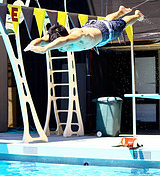
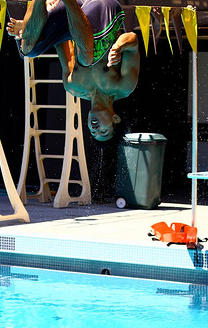
_________________________________________________
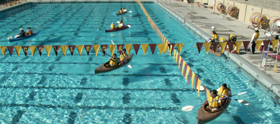
The De Anza Outdoor Club has a kayaking lesson in the De Anza pool each quarter on a weekend. Details and a few pictures from previous lessons are posted at:
kayaking / canoeing lessons
_________________________________________________
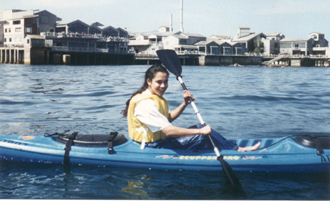
![]()
The Outdoor Club (usually May and October) Monterey ocean kayak day trip
_________________________________________________
I recommend volunteering at a Escape from Alcatraz swim BEFORE you try to swim it:
Escape from Alcatraz ‘Sharkfest’ swim volunteering
and participating in an Outdoor Club beginners Monterey kayak trip first will give you enough kayaking experience to volunteer.
 Pictures from the October 22, 2018 trip are at:
Pictures from the October 22, 2018 trip are at:
https://marydonahue.org/monterey-kayak-day-trip-october-2017
____________________________________________________________
Former De Anza student Ken Mignosa, (who yours truly trained at De Anza as a Red Cross lifeguard, mentored as a Lifeguard Instructor and then as a Lifeguard Instructor Trainer, and who I occasionally teach with in lifeguard classes at the Fremont High School pool in Sunnyvale for the California Sports Center),
completed a 41-mile marathon swim, for 29 hours and 22 minutes, starting in Oxnard, swimming around Anacapa Island to Santa Cruz Island and then back to Oxnard on Sept. 21, 2018.
An article in the Silicon Valley Voice
https://www.svvoice.com/santa-clara-mans-passion-for-swimming-takes-him-into-new-waters/
said:
“It was a swim no one had ever accomplished before and it was the second longest solo marathon swim in California Channel Islands history. . .
Amazingly, Mignosa only began attempting marathon swims in July of 2017 at the age of 53.
“I’d be in [the pool] for an hour or two and I didn’t feel like it was enough,” said Mignosa. He laughs and says that the other downside was having to turn around too soon.
Now Mignosa swims in the San Francisco Bay where he only has to turn around when he’s ready to. Marathon swimmers are not allowed to use a wetsuit in challenges because it adds buoyancy to the swimmer, so Mignosa doesn’t wear one while training.
“Ideally, anything I do for training is colder than what I do for the marathon swim,” said Mignosa. “As long as you keep moving, it tends to be okay.”
Ken “completed the California Triple Crown in 2017 which includes a swim across Lake Tahoe, a swim from Catalina Island to the Mainland, and a swim from the Mainland to Anacapa Island . . .
. . . Mignosa now has his sights set on completing the Triple Crown of Open Water Swimming. He has already completed two of the swims — from Catalina Island to the Mainland and the Manhattan Island Marathon Swim which takes you around Manhattan Island in New York. All that he has left is to swim the English Channel.”
Ken told me that the English Channel swim can cost, with the required official crew in a boat nearby, as much as $10,000.
__________________________________________________________
__________________________________________________________
On a weekend, Jan. 31 to Feb. 2, 2020, THIRTIETH ANNUAL Yosemite Valley Winter Camping trip.
Usually one of our biggest trips. Rain? Snow? Sleet? Sunshine? Raccoons (quite possibly IN the tents, but you don’t have to camp, you can get a heated tent cabin or even better overnight accommodations), Coyotes! Campfires! Night hikes, early morning hikes, long hikes to viewpoints above the valley, snowboarding, skiing, Ranger walks, Ranger snowshoe walks, ice skating, snow sculpture building. Many years we have people who have never been camping before and/or have never been in the snow. (So they’ve never been in a snowball fight, either.) Snow Camp
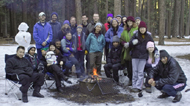
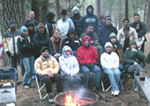
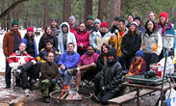
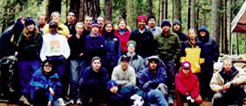 ”
”
_________________________________________________
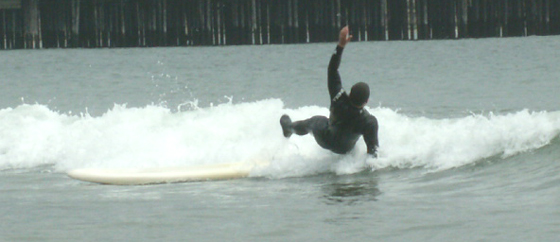 Outdoor Club surfing lessons spring quarter
Outdoor Club surfing lessons spring quarter
If you would like to do some reading about swimming strokes, or swimming in general, try American Red Cross Swimming and Water Safety. Its public libraries number is 797. This is the text for the Red Cross swimming teacher certification Water Safety Instructor.
The American Red Cross Swimming and Water Safety Manual
might still be downloadable for free at:
https://www.redcross.org/images/MEDIA_CustomProductCatalog/m3240085_SwimmingWaterSafety.pdf
The Cooper 12 minute swim test is on page 195, where it says “The 12-minute swimming test, devised by Kenneth Cooper, M.D., is an easy, inexpensive way for men and women of all ages to test their aerobic capacity (oxygen consumption) and to
chart their fitness program.”
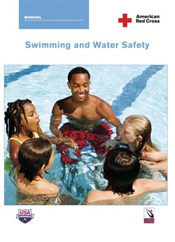
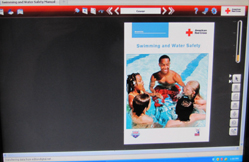
(The American Red Cross Swimming and Water Safety Manual had no index, so I wrote one: Swimming and Water Safety 2009 index).
To get a free download of the copyrighted 2016, released 2017 American Red Cross Lifeguarding Manual go to:
https://www.instructorscorner.org/s/welcome
This will get you to a page that says:
Instructor Candidate Resources
Instructions, course materials and resources
Then scroll down to and click on Lifeguarding (or any other program that interests you)
then scroll down to
Lifeguarding Manual June 2017 Document
and click for the download.
– – – – – – – – – – – – – – – – – – – – – – – – – – – – – – – – – – – – – – – – – – – – – – – – – – – – – – – – – –
The Red Cross prerequisite swim tests are described at: Lifeguard Training FAQS That page has lots of how to pass the tests advice, including some of the standards expected by the Red Cross and is worth reading thoroughly if you are tempted to try a lifeguard class.
_________________________________________________
De Anza College home games usually has the dates of the campus blood drives as well links to student recitals, dance performances and art exhibitions.
_________________________________________
![]()
programs for student success in all kinds of classes, including tutorials, readiness, academic skills, instructional computing and more:
http://deanza.edu/studentsuccess/
More students qualify for financial aid than use it or even know they qualify. There are enrollment fee waivers you can apply for online which take about a week to get an answer. For all the details go to:
http://www.deanza.fhda.edu/financialaid/index.html
You don’t have to pay for all your classes/fees at once. De Anza has an installment payment plan that allows you to defer most of your payments. Go to: http://deanza.edu/cashier/installment_plan.html
De Anza College offers many scholarships, some of which have few applicants!
Check out the loot:
http://deanza.edu/financialaid/types/scholarships.html
The De Anza College Food Pantry (also known as the Campus Cupboard) provides food to students in need. You can get a bag of groceries with few forms to fill out. http://deanza.edu/outreach/food_pantry.html
Various local businesses give discounts to De Anza Associated Student Body card holders. A page of discounts (mostly 10% off food) is at http://www.deanza.edu/dasb/discounts.html/index.html
You can read the curriculum, (course outline or course content, usually designed by a division then reviewed and approved by the college) for any De Anza class at: http://ecms.deanza.edu/deptoutlinespublic.html
De Anza College offers offers help to quit smoking http://www.deanza.edu/healthservices/quitsmoke.html
“Family Issues, romantic relationship difficulties, anxiety, stress” and other personal issues should preferably be dealt with while they are not a big deal, before they do become a big deal. “From time to time, problems of everyday living can be resolved through talking with friends, family, or someone whom we trust to help us. However, there are times when seeking help outside of one’s familiar environment might be more helpful. Psychological Services is here to meet such needs.”
How to tell if the lifeguards are doing their job properly
The aim of this page is to provide swimmers, parents, child care providers and other swimming pool patrons with a few guidelines to help them determine if the lifeguards at the pool they go to are doing their jobs properly.
_______________________________
Many of my students ask me if I can teach their children to swim.
De Anza only has swim classes for teens and adults. For swim classes for kids (infants, toddlers or children), I recommend Sharky’s Swim School in San Jose. The owner is a graduate of De Anza lifeguard training, with 25 plus years of experience teaching babies and children to swim. The pool is kept warm so you and your baby won’t be cold. https://www.facebook.com/Sharkysswim
I recommend that if they have the time, all my swim students should also take KNES 50A/50L, and use the Lifetime Fitness and Wellness Center.

Do it yourself earthquake preparedness
earthquake home hazards survey
Community Emergency Response Team training
__________________________________________________
When you call 911 from a land line telephone, such as in your house, you get dispatch for the city the phone (your house) is located in. When you call 911 from a cell phone
you get the Highway Patrol at a central location. Sometimes, especially if you are not calling about something on the freeway/highway, it would be faster to get dispatch for the specific city the problem is happening in.
This requires knowing the direct dial seven digit phone number for each dispatch. In Cupertino, the number to get help quicker is 299-2311.
Direct dial emergency phone numbers for most cities in Santa Clara County, California, can be found at the Santa Clara County ARES/RACES (Amateur Radio Emergency Services/Radio Amateur Civil Emergency Services) website.
http://www.scc-ares-races.org/dd-emer-nos.html
San Mateo County cities (and the San Francisco airport) direct dial phone numbers can be found at:
http://www.blackberryreact.org/smco911phones.html
– – – – – – – – – – – – – – – – – – – – – – – – – – – – – – – – – – – – – – –
The deadline to register to vote for any election is 11:59:59 p.m. Pacific Time on the 15th calendar day before that election. If you will be 18 years old by the election day, but are not yet 18 by the registration deadline, you can still register to vote while you are 17. If you are homeless or living out of your car you can register to vote. There is no literacy requirement. If there are a multitude of items on the ballot and you only vote on one of them, your vote will still be counted. You can register to vote online, (using a computer, iPad, tablet or smartphone) at http://registertovote.ca.gov

